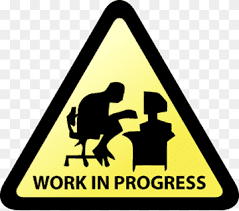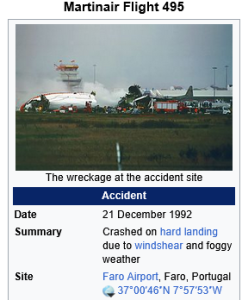Page started: June 18, 2025.
Page most recent edited: November 24, 2025.
 In the coming months I intend to work on this text.
In the coming months I intend to work on this text.
Truth is the most valuable thing we have. Let us economize it.
Mark Twain
Urban myth
A story or statement that is not true but is often repeated, and believed by many to be true.
dictionary.cambridge.org
Windshear is not the cause (nor a contributing factor) of the Martinair crash in Faro.
But, for many it still is.
About this page
After many years (decades even) and information on the crash and its causes I never expected this page to be necessary.
After consulting in June 2025 several web-pages on the crash (also Wikipedia), I noticed that the fact-bending untruth of (unexpected) windshear as cause of the crash still leads a tenacious life.
This poses the threat that generative artificial intelligence, like ChatGPT, will act as an amplifying echo chamber for this disinformation.
If primary sources are mentioned at all in the AI-outcome, a great number of users will not factcheck the AI-outcome against primary sources, such as the official investigation report. .

With this page I hope to inform readers better and encourage web-administrators to amend their text.
Origin of the windshear-myth
– Martin Schröder, day after the crash in press-conference with Dutch Minister of Transport
– Was the windshear-theory a deliberate imagery to prevent from looking into underlying causes of the crash, such as corporate and sectoral safety culture?
‘Faro’ meets the scenario for a crash (Article in Dutch newspaper Reformatorisch Dagblad, 19 Dec. ’98)
From this article (original Dutch text translated into English).
‘Iceberg
Admittedly, with the wisdom of hindsight, it’s always easy to make the right decision [on preventing the crash].
However, the crew certainly did not lack alarming data during the approach to Faro.
The pilots knew much more than, for example, director Martin Schröder, who quickly stated that windshear had led to the dramatic outcome of the flight.
Surely he should have realized that someone who names the cause 24 hours after such a disaster is always speaking out of turn.
People who have been in aviation for several decades know that a crash is almost always the result of a complex of factors. In this respect, ‘Faro’ fully meets the scenario applicable to dozens of aircraft accidents.
In such a complex, the crew is often just the tip of the iceberg.
In this case the company Martinair is responsible for a significant part of the iceberg that still exists to this day.’
The above opinion fits with the 1991 Dutch view: look beyond pilot error for causes of plane crash
“Often the crew is to blame, but there is usually a whole story behind that. If you do nothing about this [the story behind], you haven’t made any progress at all…”
Benno Baksteen [then president of Dutch Airline Pilots Association] on causes of air accidents in the 1991 book De Zwarte Doos – (The Black Box).
1998 public unrest of Martinair pilots on their workload
The blunt reaction of Martinair’s spokesperson to the unrest in 1998 (6 years after the crash) of Martinair pilots because of their workload, makes scrutiny of Martinair’s management and safety culture in 1992 even more urgent.
From, translated, article in Dutch newspaper Trouw.
Martinair’s spokesperson:
“… The pilot must always judge for himself whether he is equipped enough to take to the air. There are situations when you [Martinair operations] suddenly need a substitute. A passenger doesn’t care if a pilot is sick or nauseous. The passenger wants to get to his destination.”
From the official investigation report (1994)
– Windshear is not mentioned in probable causes and contributing factors.
– The NTSB also doubts windshear. From NTSB letter in this report:
“If the commission feels that windshear was present during the approach then consideration should be given to recommending implementation or review, of crew training for windshear recovery. ‘
Some interesting topics from the investigation report:
– page 32, 1 .6.2.3: no airworthiness directive for engine no. 3
– page 76, 1 .15.2: fire and alarm, 1 ½ minute before crash
– page 108, 2.2.3: passivity of captain throughout whole approach
AvioConsult, report (2017) the last 80 seconds of flight MP495
From this report, 1.3.1 Application of Procedures:
1.3.1.1 The CVR transcript proves that the airplane was not configured in-time for the approach and landing (§ 4.1.4). Landing gear extended, flaps and slats too late, approach speed not attained.
The crew did not follow the prescribed procedures.
1.3.1.2 The required calls for approach safety at altitudes 500 ft and 50 ft were not given by the captain and flight engineer, and not by the pilot-flying, the copilot, either.
In addition, other procedural and safety related calls were not given either.
The cockpit crew did not adhere to the AOM-prescribed crew coördination procedures. (§ 5.6.1 and § 5.12.5).
Martin Schröder’s denial of court of The Hague “verdict of 2020
From analysis of verdict
“In the final decision of 8 January 2020, the Court of The Hague held that …
– in the final Accident Report of the Portuguese Investigation Council, windshear is not recognized as a cause, and
– several so-called “missed calls” from the crew, as well as the need to abort landing due to the instability during the approach of the aircraft [should have been identified].
May 2021, Martin Schröder seems not to accept the court’s verdict on errors by his pilots
Finally
On evaluating the pilots’ performance
What if this flight was a proficiency check, would the pilots have passed?
